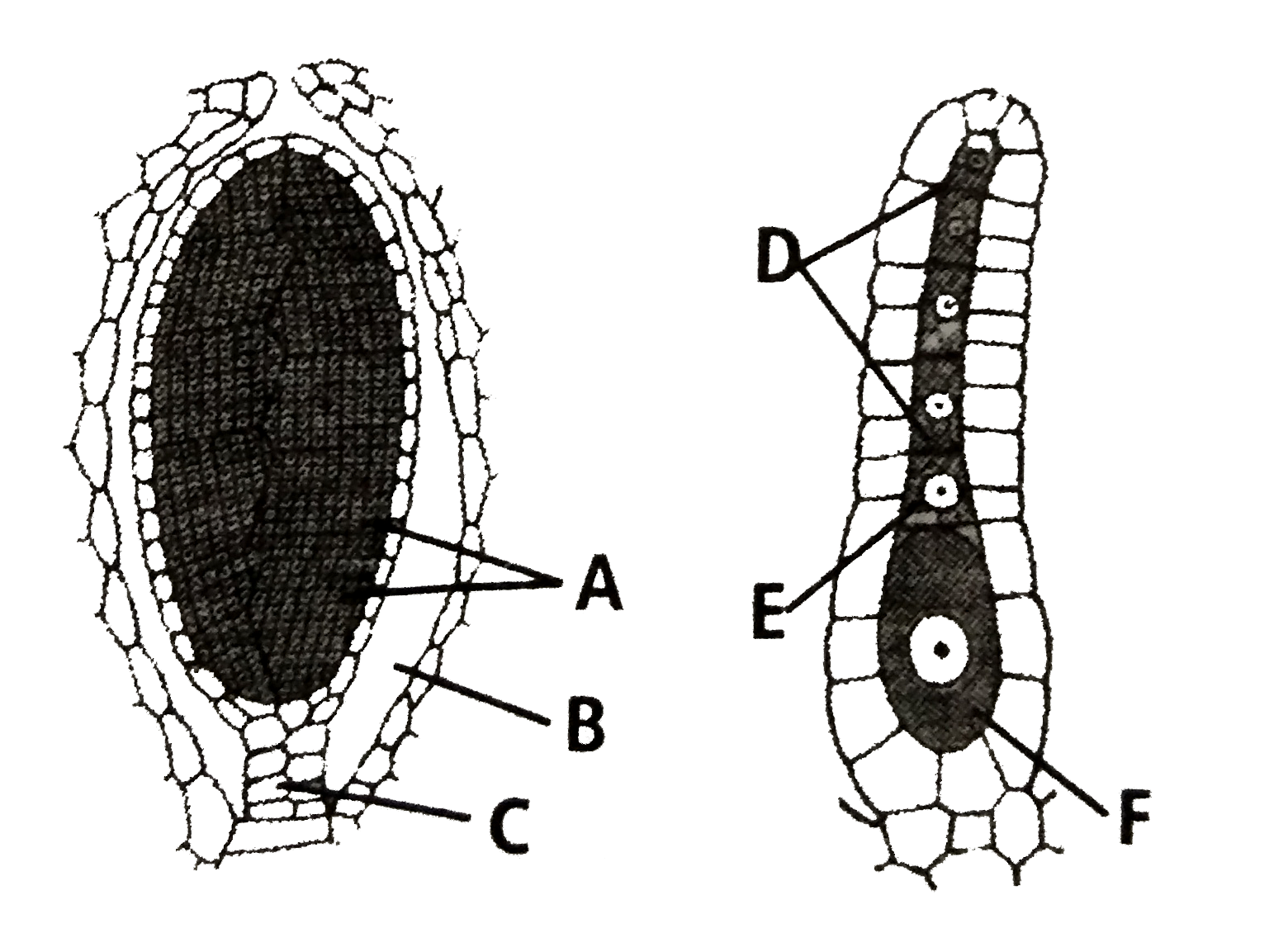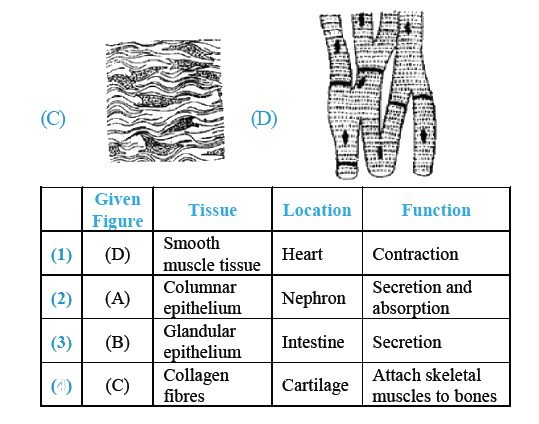Given below are some organisms.
I. Fowl II. Humans III. Grasshopper
Following alphabets related to the above animals.
Male homogametic-A
Female heterogametic-B
Male heterogametic -C
Female homogametic -D
Which of the following option correctly describes the above animals in terms of sex determination?
(I II III),(A,B C,D C,D)
(I II III),(C,D A,B C,D)
(I II III),(A,D C,D A,D)
(I II III),(B,C C,D A,B)
The correct Answer is:A
To solve the question regarding the sex determination of the given organisms (Fowl, Humans, and Grasshopper), we will analyze each organism based on their chromosomal patterns and determine the correct representation for male and female gametic conditions.
1. Identify the sex determination system in Fowl:
- Fowls have a ZZ/ZW sex determination system.
- Males are ZZ (homozygous), and females are ZW (heterozygous).
- Therefore, for Fowl:
- Male: Homogametic (A)
- Female: Heterogametic (B)
2. Identify the sex determination system in Humans:
- Humans have an XX/XY sex determination system.
- Females are XX (homozygous), and males are XY (heterozygous).
- Therefore, for Humans:
- Male: Heterogametic (C)
- Female: Homogametic (D)
3. Identify the sex determination system in Grasshopper:
- Grasshoppers have an XX/XO sex determination system.
- Females are XX (homozygous), and males are XO (heterozygous).
- Therefore, for Grasshopper:
- Male: Heterogametic (C)
- Female: Homogametic (D)
4. Summarize the findings:
- Fowl: Male (A), Female (B)
- Humans: Male (C), Female (D)
- Grasshopper: Male (C), Female (D)
5. Match the findings with the options:
- The correct representation for the organisms in terms of sex determination is:
- Fowl: A (Male homogametic), B (Female heterogametic)
- Humans: C (Male heterogametic), D (Female homogametic)
- Grasshopper: C (Male heterogametic), D (Female homogametic)
6. Determine the correct option:
- The only option that correctly describes all three organisms based on the analysis is the first option.
Final Answer:
The correct option is the first one, which states:
- Fowl: A (Male homogametic), B (Female heterogametic)
- Humans: C (Male heterogametic), D (Female homogametic)
- Grasshopper: C (Male heterogametic), D (Female homogametic)
- Fowls have a ZZ/ZW sex determination system.
- Males are ZZ (homozygous), and females are ZW (heterozygous).
- Therefore, for Fowl:
- Male: Homogametic (A)
- Female: Heterogametic (B)
- Humans have an XX/XY sex determination system.
- Females are XX (homozygous), and males are XY (heterozygous).
- Therefore, for Humans:
- Male: Heterogametic (C)
- Female: Homogametic (D)
- Grasshoppers have an XX/XO sex determination system.
- Females are XX (homozygous), and males are XO (heterozygous).
- Therefore, for Grasshopper:
- Male: Heterogametic (C)
- Female: Homogametic (D)
- Fowl: Male (A), Female (B)
- Humans: Male (C), Female (D)
- Grasshopper: Male (C), Female (D)
- The correct representation for the organisms in terms of sex determination is:
- Fowl: A (Male homogametic), B (Female heterogametic)
- Humans: C (Male heterogametic), D (Female homogametic)
- Grasshopper: C (Male heterogametic), D (Female homogametic)
- The only option that correctly describes all three organisms based on the analysis is the first option.
The correct option is the first one, which states:
- Fowl: A (Male homogametic), B (Female heterogametic)
- Humans: C (Male heterogametic), D (Female homogametic)
- Grasshopper: C (Male heterogametic), D (Female homogametic)
Topper's Solved these Questions
- PRINCIPLES OF INHERITANCE AND VARIATIONBOOK - AAKASH SERIESCHAPTER - PRINCIPLES OF INHERITANCE AND VARIATIONEXERCISE - EXERCISE -II
70 Videos
- PRINCIPLES OF INHERITANCE AND VARIATIONBOOK - AAKASH SERIESCHAPTER - PRINCIPLES OF INHERITANCE AND VARIATIONEXERCISE - EXERCISE -II (Sex determination & Genetic Disorders)
46 Videos
- PRINCIPLES OF INHERITANCE AND VARIATIONBOOK - AAKASH SERIESCHAPTER - PRINCIPLES OF INHERITANCE AND VARIATIONEXERCISE - EXERCISE-I
152 Videos
- PRINCIPLES AND PROCESSES BOOK - AAKASH SERIESCHAPTER - PRINCIPLES AND PROCESSES EXERCISE - Exercise - III (Previous AIPMT/NEET Questions)
26 Videos
- RESPIRATION IN PLANTSBOOK - AAKASH SERIESCHAPTER - RESPIRATION IN PLANTSEXERCISE - Exercise - III
9 Videos
Similar Questions
Refer the figures A , B , C and D given below. Which of the following option shows the correct name of the animals shown by the figures A , B, C and D ?

View Solution(a) In humans, males are heterogametic and frmales are homogametic, Explain. Are there any examples where males are homogametic and females heterogametic?
(b) Also describe as to, who determines the sex of an unborn child? Mention whether temperature has a role in sex determination.
View Solution
Knowledge Check

Refer to the following figures regarding division bryophyta.
(i). 'A' are the androcyte mother cells of the antheridium,
which give rise to a large number of biflagellate male gametes.
(ii). 'B' is the autheridial chamber and 'C' is multicellular stalk of antheridium.
(iii). 'D' and 'E' respectively represents venter canal cells and neck canal cell of the femal sex organ.
(iv). 'F' is the egg cell of the archegonium, which usually possesses severatl female gameters.
Which of the following combinations of above statements is incorrect?A(i) and (ii)B(iii) and (iv)C(ii) and (iii)D(i) and (iv)
In which of the following organism , males are heterogametic and have chromosome number different than females ?
View SolutionA leads to mixing of genetic material of male and female which is known as B, which result is formation of C. Fill in the above blanks with suitable option
View SolutionIn the XX-XO type of sex chromosomes in
(a) Females produce only one type of eggs
(b) Females have only one X-chromosomes
(c) Males have two X- chromosomes
(d) Males are homogametic
View SolutionRead the following statements
I) Queen bee is a diploid and fertile female with large abdomen
II) Drones are haploid and sterlie males
III) Worker bees are diploid females
In the above the correct statements are
View SolutionThe four sketches (A, B, C and D) given below, represent four different types of animal tissues. Which one of these is correctly identified in the options given, along with its correct location and function ?


View SolutionThe four figures (A, B, C and D) given below represent four different types of animal tissues. Which one of these is correctly identified in the given options along with its correct location and function ?

View SolutionThe four sketches A, B,C and D given below
represent four different types of animal tissues .
which one of these is correctly identified
in the options given along with its correct location and function ?

View Solution
